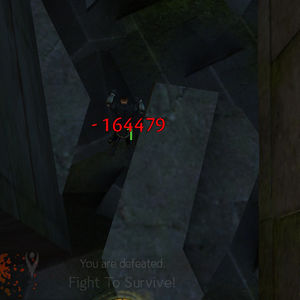User:Capric/damagedraft
“Call it whatever you like—DPS, damage per second—we just call it DAMAGE, and when it comes to making red bars go down, you can never have enough of it. Don't trivialize it though; damage is a very versatile aspect of combat. There are so many ways that a character can do damage.
— GuildWars2.com promotional material
Damage is any effect from an action which results in a target losing health. Damage is considered to be one of the three facets the Guild Wars 2 combat system is built around, the others being support and control. All professions are able to deal damage in a useful way, mostly by using skills.
There are three types of damage in Guild Wars 2:
- Direct damage. This damage is inflicted by skills and/or traits directly, can crit, and is mitigated by the target's armor.
- Condition damage. This damage is inflicted primarily by conditions, does not crit and is not mitigated by the target's armor.
- Falling damage. This damage is taken from falling. When taken below zero health by falling damage, the player does not enter a downed state but instead dies immediately. Falling damage scales with height fallen and is not mitigated by armor.
Direct damage[edit]
Base direct damage is given by the following equation:
Damage done = (weapon damage) * Power * (skill-specific coefficient) / (target's Armor)
- Weapon damage: a uniformly distributed random number taken from within the range listed as "Weapon Strength" on the equipped weapon. The weapon damage used for a skill will typically be that of the weapon associated with that skill; utility and elite skills are typically not affected by weapon damage and use a range based on the player's level.
- Power: The current Power as listed on the Hero tab, and as modified by might.
- Armor: The current Armor as listed on the Hero tab. Armor is the sum of defense and Toughness.
This base direct damage can then be modified by the following effects:
- Critical hits do increased damage. Critical hits default to 150% of base damage and this amount can be increased by the Critical Damage player attribute. Critical hit chance is governed by the Precision player attribute and the fury boon.
- Glancing blows, as caused by either level difference or weakness, only do 50% of regular damage.
- Vulnerability increases direct damage on a target.
- Protection decreases the damage received by a target by 33%.
- Other various passive effects that increase the attacker's outgoing damage or a target's incoming damage, including those from upgrade components, traits, nourishment, etc
In order for a skill to do direct damage, it first must hit. The following will result in a skill missing:
- The blind condition.
- The target blocks or dodges.
- The target is out of range of the skill or is obstructed by terrian.
- The target is invulnerable.
Direct damage is listed on skills' tooltip, as marked by Damage. Level 80 tooltip damage is given by the following equation:
Tooltip damage = (average weapon damage) * Power * (skill-specific coefficient) / (level-based Armor value)
- Some skills do not calculate their tooltip damage based on the equipped weapon. These are frequently the same skills that are unaffected by weapon strength.
- At level 80, the Armor value used is 2600.
Condition damage[edit]
The damage done by conditions is governed by the character level, the condition inflicted, and the player's Condition Damage attribute.
| Condition | Damage per stack per second or activation | Level 80 base | Condition damage per +10% increase at level 80 |
|---|---|---|---|
| Burning | 8 + (4 * Level) + (0.25 * Condition Damage) | 328 | 131 |
| Bleeding | 2.5 + (0.5 * Level) + (0.05 * Condition Damage) | 43 | 85 |
| Poison | 4 + Level + (0.1 * Condition Damage) | 84 | 84 |
| Confusion | 10 + (1.5 * Level) + (0.15 * Condition Damage) | 130 | 87 |
Note that confusion does half damage in Structured PvP.
Additionally, the total amount of damage done can be increased by the player's Condition Duration attribute, although burning, poison, and bleeding only deal damage once per second, meaning that any fractional duration is wasted for these conditions. Note that poison and burning stack in duration, so fractional duration may come into play if the duration can be extended. Damage dealt from retaliation is also considered condition damage, although its damage is based upon Power rather than Condition Damage.
Falling damage[edit]
A character that falls from a height takes simple damage as a result. The amount of damage is dependent on the distance fallen, and a fall from a sufficient height will instantly put a character into the defeated state. Fall damage is proportional to the characters health: if a level 80 and a level 1 fall the same height, the amount taken will be different, but the percentage of health taken away will be the same. Landing in deep enough water negates fall damage, although invulnerability does not.
Fall damage can be used in a fight by using effects such as fear and knockback to send the target to a damaging fall. Going down a slope can be particularly dangerous, since it's more difficult to estimate the height and angle; rather than sliding safely down, a character is often inflicted by repeated short falls that are just high enough to cause falling damage.
All professions except elementalist have a trait which halves falling damage as well as granting other effects upon receiving falling damage:
 Protector's Impact
Protector's Impact Death from Above
Death from Above Explosive Descent
Explosive Descent Soften the Fall
Soften the Fall Descent of Shadows
Descent of Shadows Descent into Madness
Descent into Madness Toxic Landing
Toxic Landing
[[Category:Game mechanics]]
